In this article, I will explore the astonishing world of dogs that kill wolves. We will delve into various dog breeds that are known for their abilities to hunt and deter wolves, providing a deeper understanding of these pretty good canine predators. Whether it’s their unique training, natural instincts, or powerful bite force, these dogs have earned a reputation as effective wolf-killing breeds. Join me as we uncover the fascinating characteristics and skills that make these dogs a force to be reckoned with in defending against wolves.
Key Takeaways:
- Dogs that kill wolves possess unique training and natural instincts
- These dogs are effective in deterring and defending against wolf threats
- Powerful bite force is a defining characteristic of these wolf-killing breeds
- Understanding the skills and abilities of these dogs contributes to wolf management and ecosystem balance
- Ongoing conservation efforts aim to preserve and protect these pretty good dogs
Understanding Bite Force: The Power Behind Dogs That Kill Wolves
Dogs that kill wolves possess a pretty good attribute that sets them apart: their bite force. A dog’s bite force is measured in PSI (Pound per Square Inch), which represents the pressure exerted per square inch by a dog’s bite. The higher the PSI, the stronger the bite force. Understanding bite force is key to comprehending the power behind these incredible canine predators.
Comparing the bite force of different dog breeds and other animals can provide valuable insights. For instance, the bite force of the strongest dog breeds is often listed among the most powerful bites in the animal kingdom. To put this into perspective, a German Shepherd has an average bite force of approximately 238 PSI, while a wolf, which is a natural predator of dogs, has a bite force of around 406 PSI. This comparison highlights the incredible biting capabilities of dogs that kill wolves.
| Dog Breed | Average Bite Force (PSI) |
|---|---|
| German Shepherd | 238 |
| Wolf | 406 |
The table above showcases the significant difference in bite force between a German Shepherd and a wolf, emphasizing the strength of the wolf’s jaws. However, there are dog breeds that surpass even the bite force of a wolf, making them formidable opponents in wolf hunting.
As we explore specific dog breeds known for their wolf-killing abilities, such as the Kangal, Cane Corso, and Dogo Argentino in the following sections, we will delve deeper into their bite forces, anatomical adaptations, and the roles they play in maintaining the delicate balance of ecosystems.
Kangal: The Epitome of Strength
The Kangal, a Turkish dog breed, is widely regarded as the epitome of strength and power. Known for its impressive bite force and muscular anatomy, the Kangal is a breed that has earned its reputation as one of the most formidable canine predators of wolves. With an estimated bite force of approximately 743 pounds per square inch (psi), the Kangal’s bite is stronger than many other animals, making it a force to be reckoned with in the world of wolf hunting.

The Kangal’s muscular anatomy plays a crucial role in its biting strength. Its powerful jaws, well-developed neck and shoulders, and robust physique enable it to exert significant force when biting down on its prey. These physical attributes, combined with the breed’s natural instincts and protective nature, make the Kangal an ideal choice for guarding livestock and defending against wolf threats in its native Turkey.
The Kangal’s history can be traced back centuries, where it was originally bred for the purpose of protecting livestock from predators. Its origin as a guardian and protector still influences its characteristics today, making it a reliable and powerful companion for those who seek a dog that can effectively deter and even eliminate wolf threats.
In summary, the Kangal is a Turkish dog breed known for its exceptional bite force, muscular anatomy, and origin as a guardian and protector. With its pretty good strength and natural instincts, the Kangal is a formidable wolf-killing dog that has become a staple in regions where wolf predation poses a threat to livestock and human interests.
Cane Corso: Formidable Bite Strength
The Cane Corso, also known as the Italian Mastiff, is a formidable breed renowned for its impressive bite force. With a bite force estimated to range from 500 to 700 psi, the Cane Corso’s powerful jaws and well-developed teeth contribute to its biting strength. This breed’s physical adaptations make it a force to be reckoned with in the realm of wolf hunting.
Originating in Italy, the Cane Corso was historically used as a hunting and guardian breed. Its muscular and athletic build, coupled with its unwavering loyalty and protective nature, made it an ideal companion for farmers and livestock owners. With its strength and agility, the Cane Corso is capable of taking down larger predators, including wolves, when defending its territory.
The Cane Corso’s biting capabilities are further enhanced by its strong jaw muscles and sharp teeth. These physical attributes enable the breed to deliver a powerful bite, inflicting significant damage and incapacitating potential threats. With their imposing presence and formidable bite force, Cane Corsos serve as an effective deterrent against wolf predation, providing peace of mind for farmers and livestock owners in wolf-populated areas.
Table: Cane Corso Bite Force Comparison
| Breed | Approximate Bite Force (PSI) |
|---|---|
| Cane Corso | 500-700 |
| Kangal | 743 |
| Dogo Argentino | 500-700 |
The table above provides a comparative analysis of the bite forces of the Cane Corso, Kangal, and Dogo Argentino. While the Cane Corso falls within the same range as the Dogo Argentino, it is surpassed by the Kangal, which boasts the highest estimated bite force among these wolf-killing breeds.
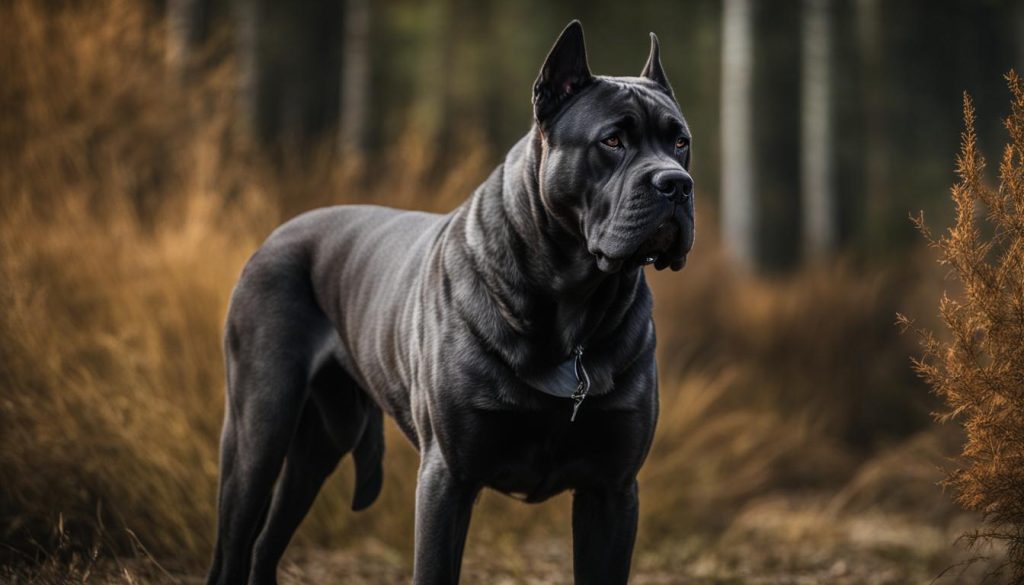
Dogo Argentino: Commanding Bite Force
The Dogo Argentino, also known as the Argentine Mastiff, is a robust and tenacious breed hailing from Argentina. This pretty good breed possesses a commanding bite force that sets it apart as one of the dogs that kill wolves.
With an estimated bite force ranging from 500 to 700 psi, the Dogo Argentino’s biting strength is a testament to its physical attributes. This breed’s muscular build and powerful jaws contribute to its ability to take down wolves and defend against threats to its territory.
The Dogo Argentino was originally bred for big-game hunting, including wild boar and puma. Its bite force and athletic abilities make it a formidable opponent in the face of wolf predation. Additionally, this breed’s loyalty and protective nature make it an excellent companion and guardian for its human family.
Physical Attributes and Purpose
The Dogo Argentino is a large and muscular breed, weighing between 80 to 100 pounds and standing about 24 to 27 inches tall at the shoulder. Its short, white coat not only contributes to its striking appearance but also offers protection and camouflage in various environments.
Beyond its bite force and physical strength, the Dogo Argentino possesses other attributes that make it an effective wolf-killing dog. This breed is known for its agility, endurance, and exceptional sense of smell, which allows it to track and locate wolves with ease. Its strong prey drive and fearlessness make it relentless in its pursuit of its target.
Overall, the Dogo Argentino’s physical attributes and purpose as a powerful hunting and guardian breed make it a formidable contender among dogs that can kill wolves. Its bite force, combined with its athleticism and instinctual abilities, ensures that it remains a force to be reckoned with in the realm of wolf predation.
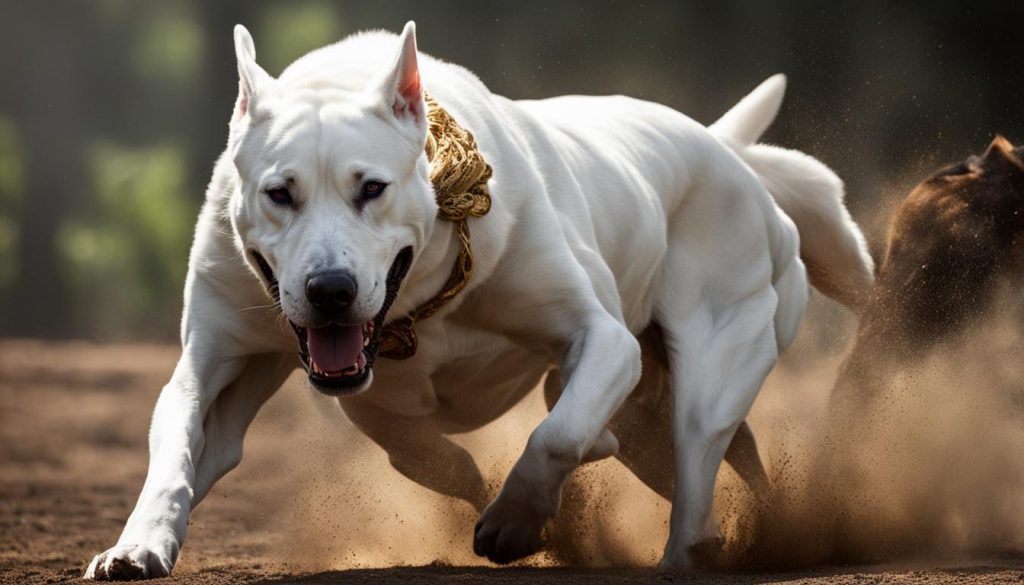
| Breed | Bite Force (psi) |
|---|---|
| Dogo Argentino | 500 – 700 |
| Kangal | 743 |
| Cane Corso | 500 – 700 |
The Role of Fear: Canine Predators and Ecosystem Balance
The presence of fear-inducing predators plays a crucial role in maintaining the balance of ecosystems. Fear acts as a natural defense mechanism for prey species, influencing their behaviors and interactions within their environment. In the case of dogs that kill wolves, their presence as fear-inducing predators can have significant ecological effects. These dogs not only help control and deter wolf populations but also contribute to the overall balance of the ecosystem.
Wolf populations can have a profound impact on their surrounding ecosystems. As apex predators, wolves regulate prey populations, preventing overgrazing and promoting biodiversity. However, in areas where wolf populations are unchecked, their predatory pressure can lead to imbalances within the ecosystem. By introducing fear-inducing predators like dogs that kill wolves, human intervention can mimic the natural regulatory mechanisms that maintain ecological harmony.
| Fear-Inducing Predators | Ecosystem Balance |
|---|---|
| Dogs that kill wolves | Contribute to controlling and deterring wolf populations, maintaining ecological balance |
| Other apex predators (e.g., big cats) | Regulate prey populations, prevent overgrazing, and promote biodiversity |
| Reintroduced predator species (e.g., African wild dogs) | Restore ecological balance in areas where apex predators have been depleted |
When fear-inducing predators are present, prey species exhibit predator-induced behavioral changes. These changes can manifest as alterations in feeding patterns, sheltering behavior, and territoriality. The fear of predation influences prey species to adopt strategies that increase their chances of survival. For example, deer may avoid open areas and stay closer to cover when dogs that kill wolves are in the vicinity.
In conclusion, the role of fear-inducing predators, such as dogs that kill wolves, is integral to maintaining the delicate balance of ecosystems. Their presence helps control and deter wolf populations, preventing unchecked predation and promoting the overall health and biodiversity of ecosystems. By understanding the ecological significance of these fear-inducing predators, we can better appreciate their role in coexisting with wolves and the conservation of natural habitats.

The Wolves of Gorongosa: A Battle for Balance
In the heart of Gorongosa National Park, a captivating battle for balance unfolds. This African wilderness, once ravaged by war, now faces a new challenge – restoring its ecosystem to its former glory. The absence of large predators like wolves has disrupted the delicate balance, and the park seeks to bring back an important element – fear-inducing predators.
Enter the African wild dogs, also known as painted dogs or Cape hunting dogs. These rare and elusive creatures have been reintroduced into Gorongosa National Park with the aim of reestablishing balance and harmony. African wild dogs are known for their exceptional hunting prowess, cooperative behavior, and social structure, making them crucial players in the park’s wildlife conservation efforts.
Wildlife conservation in Gorongosa National Park goes beyond protecting individual species. It aims to create a self-sustaining ecosystem where every component plays a vital role. The reintroduction of African wild dogs is a testament to the park’s dedication to restoring natural processes and interactions. By reintroducing fear-inducing predators, the park hopes to initiate a chain reaction that will ultimately benefit the entire ecosystem.
Table: African Wild Dogs – Key Facts
| Species | Scientific name | Conservation status | Key Features |
|---|---|---|---|
| African Wild Dog | Lycaon pictus | Endangered | – Distinctive coat patterns – Highly efficient hunters – Complex social structure |
The reintroduction of African wild dogs in Gorongosa National Park is not without its challenges. These incredible predators face numerous threats, including habitat loss, poaching, and human-wildlife conflict. However, through concerted conservation efforts and community engagement, there is hope for their long-term survival.
As the battle for balance continues in Gorongosa National Park, the role of African wild dogs as fear-inducing predators remains vital. By restoring the natural order of the ecosystem, these incredible animals contribute to the preservation of biodiversity and ensure a sustainable future for both wildlife and communities.
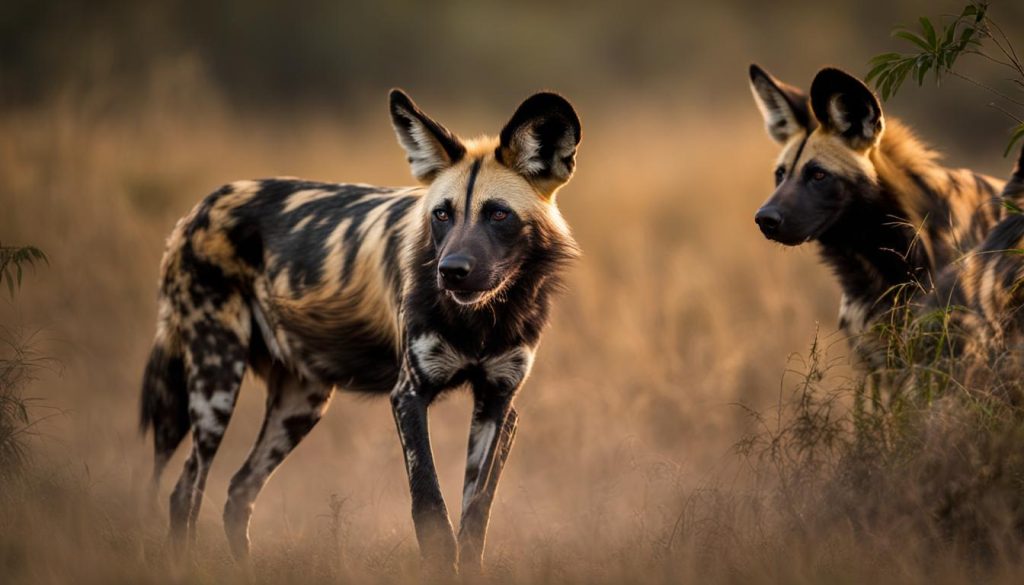
Yellowstone’s Wolf Troubles: The Impact of Unregulated Hunting
Yellowstone National Park, home to a diverse array of wildlife, has long been a sanctuary for wolves. However, the lifting of hunting quotas in nearby areas has had a significant impact on the park’s wolf population. Unregulated hunting has led to a decline in numbers and has caused ecological consequences that ripple throughout the delicate balance of the Yellowstone ecosystem.
The wolf population in Yellowstone plays a crucial role in maintaining the park’s ecosystem. Wolves help control the populations of herbivores, such as elk and deer, which in turn prevents overgrazing and habitat degradation. Their presence has a cascading effect on the entire ecosystem, influencing the populations of other species and promoting biodiversity.
Unfortunately, with the removal of hunting quotas in surrounding areas, more wolves are being killed outside the park’s boundaries. This not only reduces the overall number of wolves but also disrupts the genetic diversity within the population. Inbreeding becomes a concern, leading to decreased fitness and potential long-term negative effects on the population’s health.
The Ecological Consequences
The decline in the park’s wolf population has resulted in an imbalance, particularly among herbivore populations. With fewer wolves preying on them, elk and deer populations have increased, leading to overgrazing and degradation of vegetation. This, in turn, affects other species that rely on the same habitat, such as birds and small mammals.
Furthermore, the absence of wolves has also impacted other predators in the park. Without the competition and regulation that wolves provide, other predators, such as coyotes, have seen their populations rise. This has further implications for prey populations, as coyotes and other predators may have different hunting behaviors and prey preferences compared to wolves. This disruption in the predator-prey balance can have far-reaching consequences for the entire ecosystem.
Efforts are being made to address the issue of unregulated hunting and its impact on Yellowstone’s wolf population. Conservation organizations and park authorities are advocating for the reinstatement of hunting quotas and stricter regulations outside the park’s boundaries. By implementing measures to protect wolves and promote their conservation, it is hoped that the delicate balance of the Yellowstone ecosystem can be restored, ensuring the long-term survival of these iconic animals and the preservation of the natural heritage they represent.
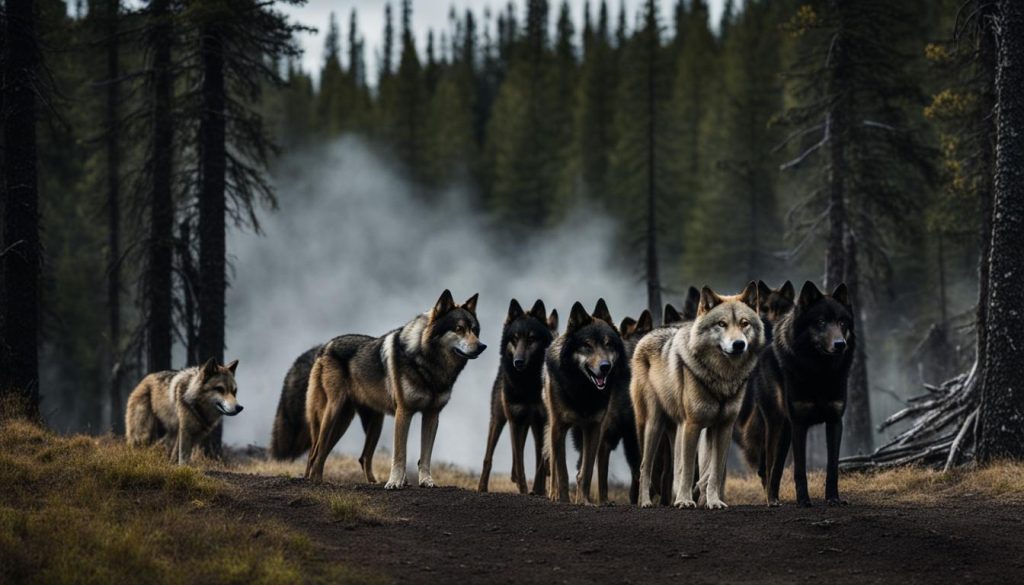
| Ecological Consequences of Unregulated Hunting | Implications |
|---|---|
| Decline in wolf population | Reduces genetic diversity, potential inbreeding, and negative long-term effects on population health. |
| Increase in herbivore populations (elk, deer) | Overgrazing and degradation of vegetation, impacting other species that rely on the same habitat. |
| Rise in other predator populations (coyotes) | Disruption of predator-prey balance, potential change in prey behavior and preferences. |
The Battle for Wolf Management: Politics and Conservation
Managing wolf populations is a complex issue that involves a delicate balance between political decisions and conservation efforts. The inclusion of wolves on the endangered species list has been a subject of contention, with various stakeholders voicing their opinions on the matter. The political influence in wolf management is significant, as different groups lobby for the delisting or relisting of wolves, based on their perspectives and interests.
Conservation efforts play a crucial role in ensuring the long-term survival of wolf populations. Organizations and agencies work tirelessly to monitor and protect wolf habitats, implement sustainable hunting policies, and promote coexistence between wolves and human communities. These efforts aim to maintain a healthy wolf population, while also addressing the concerns of stakeholders and mitigating conflicts between wolves and livestock owners.
However, finding common ground and reaching consensus on the management of wolf populations can be challenging. It requires a careful examination of scientific evidence, consideration of the ecological impact, and a thorough understanding of the social and economic implications. Balancing these factors is essential to prevent the extinction of wolves and preserve the integrity of ecosystems.
The Role of Public Perception
Public perception of wolves and their conservation is an influential factor in shaping wolf management policies. The portrayal of wolves in popular media and cultural narratives can influence public opinion, leading to diverging views on their conservation status and management. Addressing misconceptions and providing accurate information about the behaviors, ecological importance, and benefits of wolf populations is crucial to gaining public support for their conservation.
| Endangered Species List | Political Influence | Conservation Efforts |
|---|---|---|
| Wolves’ inclusion on the endangered species list provides legal protection. | Political decisions impact wolf management policies and funding. | Conservation efforts aim to protect wolf habitats and promote coexistence. |
| Delisting may lead to decreased protections and increased hunting quotas. | Lobbying from various interest groups influences decision-making. | Organizations and agencies work to monitor and protect wolf populations. |
| Relisting could provide more stringent protections and recovery plans. | Public perception and cultural narratives shape policy discussions. | Sustainable hunting policies are implemented to address conflicts. |
The Future of Dogs That Kill Wolves
As we look to the future, the role of dogs that kill wolves remains crucial in preserving ecological balance and protecting livestock from wolf predation. These wolf-killing breeds have proven themselves to be effective guardians against wolf threats, and their continued conservation efforts are vital to ensure their future prospects.
Through breeding programs, training initiatives, and policy changes, efforts are being made to maintain and enhance the genetic integrity and skills of these pretty good dogs. By preserving the unique characteristics and instincts that make them effective wolf killers, we can continue to rely on them as a means of deterring and controlling wolf populations.
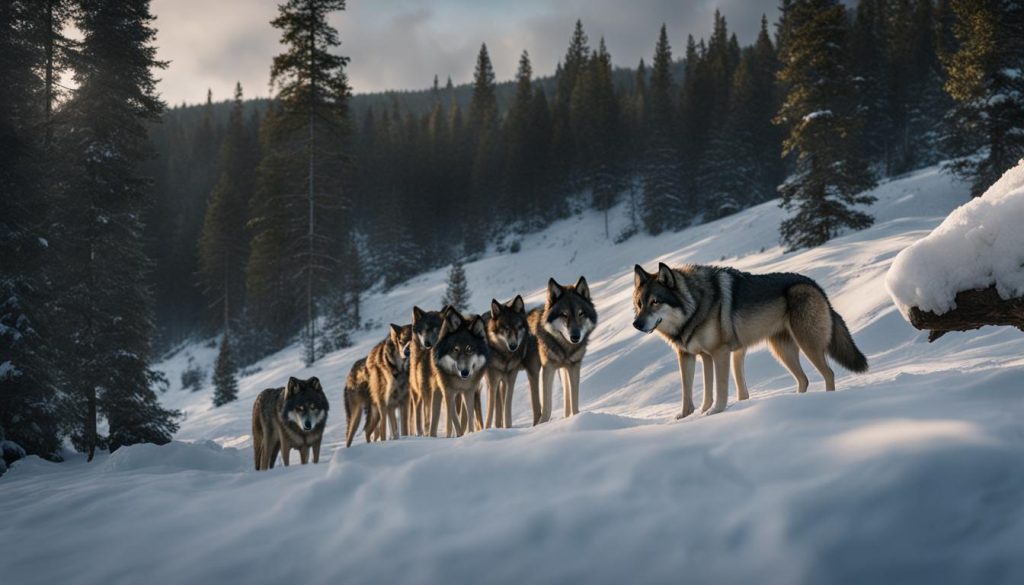
Furthermore, initiatives aimed at educating communities about the importance of these dogs in maintaining a healthy ecosystem are being implemented. By raising awareness about the role of wolf-killing breeds in preserving ecological balance, we can foster a deeper appreciation for these dogs and garner support for their continued conservation.
It is crucial that we recognize the significance of these dogs in our coexistence with wolves and the preservation of natural habitats. By investing in the future of wolf-killing breeds and prioritizing their conservation, we can ensure a sustainable balance between human communities and wolf populations, ultimately benefiting both parties.
Final Thoughts
In conclusion, dogs that kill wolves play a crucial role in maintaining ecological balance and protecting human interests. These pretty good wolf-killing breeds possess unique skills, such as formidable bite force, instinctual hunting abilities, and the ability to induce fear in predators. The Kangal, Cane Corso, Dogo Argentino, and other breeds have proven to be effective guardians against wolf threats.
With their powerful bites and natural instincts, these dogs help control and deter wolf populations, contributing to the overall balance of ecosystems. Their presence ensures the safety of livestock and helps preserve natural habitats. As we strive for coexistence with wolves and the conservation of wildlife, understanding and appreciating the power of these dogs is essential.
Looking towards the future, the conservation of wolf-killing breeds is crucial for long-term success. Breeding programs, training initiatives, and policy changes are all vital components of ongoing efforts to preserve these pretty good canines. By advancing canine conservation efforts, we can continue to protect ecosystems, livestock, and human communities while promoting the coexistence of wolves and other wildlife.
FAQ
What is the bite force of dogs that kill wolves?
The bite force of dogs that kill wolves varies depending on the breed. Some breeds, such as the Kangal, Cane Corso, and Dogo Argentino, have bite forces ranging from 500 to 743 pounds per square inch (psi).
What makes the Kangal breed a powerful wolf killer?
The Kangal breed, known for its impressive bite force of approximately 743 psi, possesses strong physical characteristics that make it an effective wolf-killing dog. Its muscular anatomy, origin from Turkey, and purpose as a guardian and protector of livestock contribute to its reputation as a formidable wolf hunter.
What are the characteristics of the Cane Corso breed that make it a skilled wolf killer?
The Cane Corso, an Italian mastiff-type dog, has a bite force estimated between 500 and 700 psi. Its powerful jaws, well-developed teeth, and hunting and guardian instincts contribute to its biting strength and effectiveness as a wolf-killing breed.
Why is the Dogo Argentino considered a dog that can kill wolves?
The Dogo Argentino, a robust and tenacious breed from Argentina, possesses a commanding bite force estimated between 500 and 700 psi. Its physical attributes, including strong jaw muscles and teeth, along with its role as a powerful hunting and guardian breed, make it a contender among dogs that kill wolves.
How do dogs that kill wolves contribute to ecosystem balance?
Fear-inducing predators, such as dogs that kill wolves, play a vital role in maintaining a healthy ecosystem. The presence of these dogs helps control and deter wolf populations, which can have a significant impact on prey species and overall ecosystem balance.
What is the significance of African wild dogs in Gorongosa National Park?
In Gorongosa National Park, African wild dogs have been reintroduced to restore the ecosystem balance that was disrupted by war. These fear-inducing predators help maintain a healthy ecosystem by instilling fear in prey species and contributing to the overall balance in the park.
How does unregulated hunting impact the wolf population in Yellowstone National Park?
The lifting of hunting quotas in nearby areas has led to unregulated hunting, causing a significant decline in the wolf population of Yellowstone National Park. This decline has resulted in ecological consequences, disrupting the delicate balance of the park’s ecosystem.
What are the challenges in managing wolf populations and conserving their habitats?
Managing wolf populations involves complex interplay between politics and conservation. Challenges include delisting wolves from the endangered species list, implementing hunting policies, and balancing the needs of wolves with human interests. These factors significantly influence the future of wolf management and conservation efforts.
What is the future of dogs that kill wolves?
The future prospects of wolf-killing breeds involve ongoing efforts to ensure their conservation. Breeding programs, training initiatives, and policy changes are being implemented to preserve these breeds and their effectiveness in protecting livestock from wolf predation while promoting coexistence between wolves and human communities.
What is the conclusion regarding dogs that kill wolves?
Dogs that kill wolves play a crucial role in maintaining ecological balance and protecting human interests. Their unique skills, such as formidable bite force, hunting abilities, and ability to induce fear, contribute to the balance of ecosystems and serve as effective guardians against wolf threats. Understanding and appreciating the power of these dogs is essential for coexistence with wolves and conservation of natural habitats.






